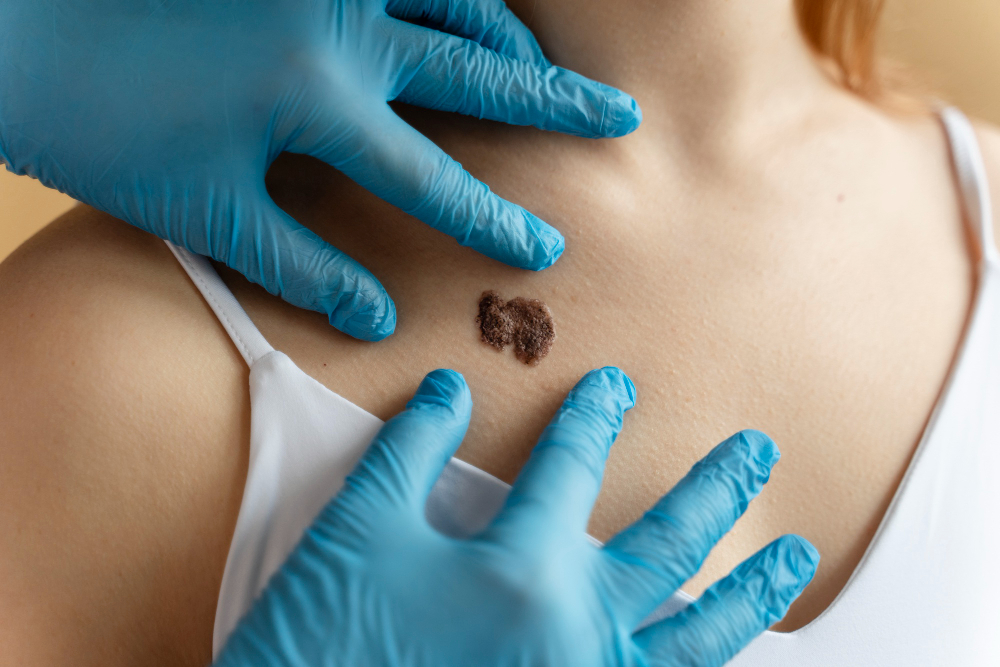The Visual Guide: Signs of Moles vs. Melanoma
Checking your skin regularly can help spot any early signs of trouble. To do a self-exam, it’s best to stand in front of a full-length mirror. Look for changes in size, shape, or color of any mole or birthmark.
The difference between birthmark and melanoma often lies in the ABCDE rule:
- Asymmetry: One half of the mole doesn’t match the other.
- Border: Edges are ragged or blurred.
- Color: Varied shades of brown, black, or even red.
- Diameter: More than 6mm across, roughly the size of a pencil eraser.
- Evolving: Changes over time in size, shape, color, or feel.
Melanoma symptoms can include not just visual changes but also sensations like itching or tenderness. If you’re unsure about a spot, it’s always best to get a professional opinion. Early detection of melanoma skin cancer means treatment can start sooner, increasing the chance of success. Remember, not all skin changes should cause panic, but being cautious can help.
The Shadows: Risk Factors for Melanoma
Several variables can increase the risk of developing melanoma. Being aware of these can help you take preventive measures. A major environmental risk is excessive sun exposure. Spending long periods outdoors without protection increases risks dramatically.
Tanning beds are another concern. Using them even just once can increase your risk of melanoma later in life. Genetically, having a family history of melanoma cancer can up your risk. Fair skin, which burns easily, is also a factor.
Besides exposure and genetic risks, certain physical attributes can play a role. People with many moles or large birthmarks might have a heightened risk. By understanding these risks, you can take more proactive steps toward keeping your skin safe, like wearing sunscreen and covering up with clothes outdoors.
Sun-Safe Habits: Prevention Methods You Need to Know
Prevention is the key to keeping your skin healthy. Start with everyday sun protection habits. Applying a broad-spectrum sunscreen with at least SPF 30 can help. Remember, sunscreens need reapplication every two hours, more often if swimming or sweating.
It’s also wise to wear protective clothing. Hats, sunglasses, and long sleeves are great choices. During intense sunlight hours, seek shade whenever possible.
Regular skin exams by a dermatologist should not be overlooked. These check-ups aid in early discovery of early stage melanoma. Annual screening can make a big difference in catching skin changes early.
While habits change, so do recommendations. Stay informed by visiting reliable sources or healthcare experts to know the latest in birthmark vs melanoma care.
Pressing Matters: Treating Melanoma and Prioritizing Skin Care
Discovering early signs of melanoma can significantly impact treatment success. Early detection involves spotting changes in your moles and consulting your doctor immediately. They may recommend a biopsy to assess the spot.
In India, various resources are available to help with screenings and care. City hospitals and clinics often have dermatology departments trained to deal with skin cancers. Also, academic hospitals may offer discounted screenings or treatment options.
Education is power, and being aware of the symptoms of melanoma cancer can aid early treatment and healing. Melanoma symptoms can include not only changes in your skin but also swelling or discomfort.
Prioritize your skin care every day. It means more than just addressing external beauty; it’s about checking for early signs of melanoma and responding swiftly. Even if a mole seems harmless, checking in with a dermatologist can provide the clarity you need. Taking skin changes seriously allows you to lead a worry-free life, focusing on the things you love without fear.

